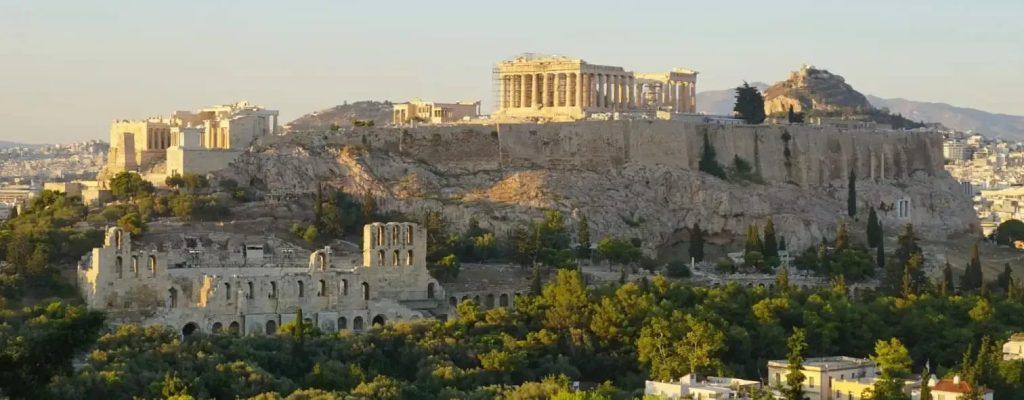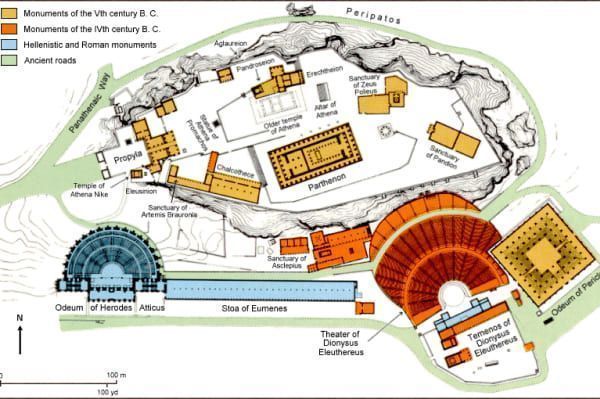We show you the map with the original view of the Acropolis and a plan with the main entrance.


The Acropolis has played a significant role in Greek history and culture and is widely regarded as one of the most important archaeological sites in the world. Its stunning architecture, historical significance, and breathtaking views of the city of Athens make it a must-see destination for anyone visiting Greece. Before you decide to visit the historical site, you must ensure to have a map with you to help you throughout your trip.

To enter the Acropolis, visitors must first make their way to the main entrance, which is located on the west side of the hill. The entrance is through a monumental gateway known as the Propylaea. Or visitors can also choose to enter from the side entrance also known as the Dionysus Theater entrance.
The main entrance’s ticket booth is where visitors may purchase Acropolis tickets. In order to avoid waiting in queue for a long time, especially during the busy tourist season, it is advised to purchase tickets in advance. You can book your tickets here online.
The Acropolis of Athens, one of the most iconic landmarks in Greece, welcoming visitors each year throughout the world has two entrances. The main entrance is through the Propylaea on the west side of the Acropolis, while the other entrance, the Dionysus Eleuthereus Gate, is on the southeastern side.
Main Entrance – located at the western side of the Acropolis.
The Propylaea is a monumental gateway, and visitors to the Acropolis must pass through it to reach the site. It was built in the 5th century BCE and is a masterpiece of classical Greek architecture. The doorway has magnificent Doric columns and an Ionic portico in the middle. The Propylaea was initially intended to act as a regal entry to the Acropolis, and it still fulfills this role today.
Near the entrance, there is a ticket counter where visitors can purchase tickets to enter the Acropolis. The ticket counter is located on the right-hand side of the entrance, just before the gate that leads to the site. It is a modern building that blends in with the surroundings, and it is open daily from 8:00 am to 8:00 pm, except for certain holidays. Visitors can purchase tickets for the Acropolis and other nearby sites, such as the Ancient Agora of Athens and the Roman Agora.
Side Entrance – located at the southeastern side of the Acropolis.
The Acropolis of Athens also has a side entrance, known as the Dionysus Eleuthereus Entrance. This entrance is located on the south slope of the Acropolis, near the Theater of Dionysus. The entrance through this gate is reserved mostly for those having small group tours and skip-the-line tours therefore the crowd at this entrance is comparatively less. The Dionysus Eleuthereus Entrance is a popular option for those who prefer a quieter entrance and a chance to explore the area around the Acropolis.
The entrance is named after the god Dionysus, who was worshiped at the theater, and the term “Eleuthereus” refers to the sanctuary of the god in the area. The Dionysus Eleuthereus Entrance is a more peaceful and less crowded entrance compared to the main entrance, and it provides a different perspective of the Acropolis. Visitors can enter the site through this entrance with a valid ticket, and they can explore the Theater of Dionysus and other attractions in the area before ascending to the main Acropolis site.
The Acropolis ticket grants visitors access to the archaeological site of the Acropolis and its slopes, including the Parthenon, the Theater…
While visiting the Acropolis in Athens is a must-see experience for anyone interested in ancient Greek history and culture, not visiting the…
Taking the metro is a quick and convenient option for getting to the Acropolis in Athens. There are two metro stations that can be used to re…
